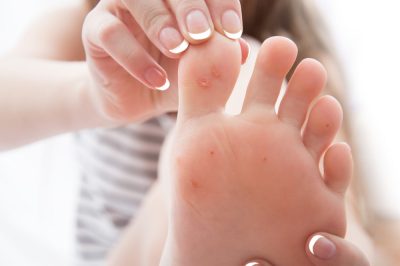
WHAT’S THE DIFFERENCE BETWEEN A CORN AND A VERRUCA?
With verruca, particularly at the early stages it can be very difficult to tell the difference between a verrucae and a corn until you have smoothed of the top layer of skin.
By visual diagnosis alone, corns are usually circular, symmetrical and clear in appearance, whereas the verrucae, can be more irregular in shape (less circular), much less clear and are usually crumbly when appraised and have black spots centrally (dried blood).
Many clients describe their verrucae as having a cauliflower appearance, and most practitioners would no doubt agree that this is a good description.
A corn is often described like having a stone in the foot. Sometimes the skin can get so hard, that this too is a fair description by the patient.
A corn is not contagious. A verruca is caused by a virus and is highly contagious. Both can be painful.
WHAT IS THE CAUSE OF VERRUCAE?
Verrucae are caused by the Human Papilloma Virus (HPV) There are hundreds of sub types of HPV but verrucae are specific to the foot.
There are currently more than 100 known types of HPV; subtypes 1, 2 and 4 are most common on the hands and feet. HPV is a highly contagious virus and is passed easily between people via invisible cuts or abrasions on softened (macerated) skin on the soles of the feet. Once infected the virus remains latent in the basal layer of the epidermis from 1 – 8 months. HPV thrives in warm, damp and moist environments particularly:
- Communal changing rooms floors
- Communal shower area
- Swimming pools
CAN YOU GET A VERRUCA ON YOUR HAND?
No but you could get one of the other sub types of HPV.
HOW ARE VERRUCA TREATED?
There are a number of over the counter products, usually in the form as caustics containing salicylic acid or silver nitrate. However, the strength of the acid can vary from product to product.
Before topical treatment can be applied it is important that the callus (hard skin) that often forms over the verruca is removed. Treatment is applied and a dressing and padding may be necessary. In-between clinic visits home treatment is vital to increase the chances of a successful outcome.
Chiropody Clinics have a number of options available to treat verrucae, usually as a course of one of the following treatments;
- Cryotherapy (freezing) with liquid nitrogen or Nitrous Oxide
- Caustics such as salicylic acid (a keratolytic)
- Silver Nitrate, which is generally accepted as more mild caustic than salicylic acid
It’s important to note, that application of any chemical to the skin should be applied with caution. People with skin sensitivities and reduced circulation or ability to heal should be especially careful or avoid this type of treatment all together.
Diabetics should heed the advice that it is not sensible and potentially dangerous to apply an acid or caustic to their skin. Your Chiropodist would not recommend this method for diabetic feet.
Treating verrucae is a long and laborious undertaking which can become frustrating. Because verrucae have different durations, sizes and locations there are no guarantees of successfully resolving verrucae. After 6 treatments if verrucaes were not resolved alternative treatment options would be explored.
